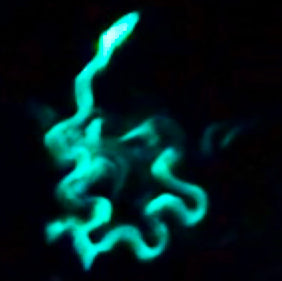PyroDinos: The Marvels of Asexual Reproduction and Immortal Cells

PyroFarms isolated a single PyroDino cell off the coast of San Diego in 2009. From this single cell, PyroFarms has grown everything we have.
In the vast expanse of the world's oceans resides an extraordinary organism that captivates scientists and ocean enthusiasts: Pyrocystis fusiformis, bioluminescent microalgae. Also referred to as phytoplankton, we call them PyroDinos. PyroDinos possess a fascinating ability to reproduce through asexual means, giving rise to an eternal lineage of cells.
PyroDinos are known for their stunning display of bioluminescence. When agitated or disturbed, these tiny unicellular cells emit a soft blue-green glow, creating breathtaking displays of light in the ocean waters. However, beneath its mesmerizing exterior lies a truly remarkable mode of reproduction.

Asexual Reproduction: The Key to Immortality: PyroDinos rely predominantly on asexual reproduction, a process that enables it to perpetuate its lineage indefinitely. This form of reproduction does not involve the exchange of genetic material but instead relies on the division of a single parent cell into two daughter cells.

Binary Fission: Dividing and Multiplying: The primary method of asexual reproduction in Pyrocystis fusiformis is binary fission. The process begins when the parent cell undergoes mitosis after reaching a specific size and physiological state. During mitosis, the genetic material within the cell is duplicated, and the organelles divide equally between the two resulting daughter cells. Eventually, the parent cell splits into two separate entities, each with the complete genetic information necessary to function autonomously.

One of the most intriguing aspects of PyroDino asexual reproduction is that the daughter cells can independently survive. Once the parent cell divides, the two daughter cells can live and reproduce, each continuing their parent's lineage. This process can continue indefinitely, resulting in an immortal population of genetically identical cells.

PyroFarms relies on this immortal concept to continually propagate our PyroDino cell cultures. By continuously adding nutrient-enriched purified seawater (DinoNutrients) and providing natural and artificial light, PyroFarms can produce large volumes of PyroDinos in a short period of time. For example, PyroFarms can cultivate a 50-liter culture into a 100-liter culture in a few days.

PyroFarms is here to help you grow as many PyroDinos as you can. PyroDinos are easy to grow and only require daily light. PyroDinos also remove the greenhouse gas CO2 from the atmosphere, so the more we grow, the better off we all are. PyroFarms has a video on container preparation and expansion feeding. We also have in-depth instructions on how to maximize growth and make your own artificial seawater.
The Significance of Immortal Cells: The concept of immortal cells, as observed in PyroDinos, carries profound implications. While most organisms eventually succumb to aging and mortality, PyroDinos defy this fundamental limitation by continuously producing genetically identical offspring. The immortality of these cells allows them to persist in their environment, maintaining stability and perpetuating their species over long periods.

Adaptation and Environmental Resilience: Our PyroDinos' ability to reproduce asexually and maintain an immortal lineage has likely played a crucial role in their adaptation and resilience to various environmental conditions. By avoiding the need for sexual reproduction, which requires the presence of compatible mates, Pyrocystis fusiformis can quickly and efficiently reproduce, ensuring the survival of its genetic information in response to changing environmental pressures.
These remarkable PyroDinos give us a glimpse into immortal cell wonders. This bioluminescent phytoplankton perpetuates its lineage indefinitely through binary fission, resulting in a population of genetically identical, immortal cells. This unique reproductive strategy contributes to the adaptability and resilience of PyroDinos, enabling them to thrive in diverse oceanic environments.






Comments
Ken Torrey —
My new family of all daughters is growing and glowing well! I saw a large number of their relatives at night in the wake of my sizable ship, the USS Carl Vinson CVN-70, in my Navy days. They glowed leaving a visible blue trail in our wake, just like the scene in the movie, Apollo 13, where former naval pilot, Jim Lovell, told the story of how pyrodinos helped him find his aircraft carrier!